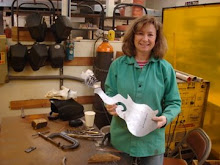
My whole life I have been drawn to Monet and his paintings. Hanging in my house are 36” square reproductions of Water Lilies and Bridge over a pond of Water Lilies at Giverny. I did not know what it was in his work that drew me in, but whatever it was, it resonated with me at a very deep level. When I traveled to Europe for college in1985, I went on a pilgrimage to Paris to see Claude Monet’s Water Lilies in the Musee de L’Orangerie. It was a breathtaking experience to sit in front of the 8 paintings, 4 in each of 2 oval rooms designed specifically for these monumental works (each about 19 feet long by 6 feet tall). The museum closed from 1999 to 2006 and reopened just in time for me t
 o see it in its newly remodeled space the summer of 06 with my kids. The museum has kept the original 2 oval rooms that I saw in 85 that were designed specifically for these paintings, but they created openings in the ceiling to flood the rooms with natural sunlight to view them in a more natural setting. When I was reading about Monet this week in the text book, I came across a quote that helped me to understand why I so love Monet, and have always connected to his works. This is the statement made by Monet when he spoke to an artist friend, “When you go out to paint, try to forget what objects you have before you- a tree, a house, a field or whatever. Merely think, here is a little square of blue, here is an oblong of pink, here is a streak of yellow, and paint it just as it looks to you, the exact color and shape, until it gives your own naïve impression of the scene
o see it in its newly remodeled space the summer of 06 with my kids. The museum has kept the original 2 oval rooms that I saw in 85 that were designed specifically for these paintings, but they created openings in the ceiling to flood the rooms with natural sunlight to view them in a more natural setting. When I was reading about Monet this week in the text book, I came across a quote that helped me to understand why I so love Monet, and have always connected to his works. This is the statement made by Monet when he spoke to an artist friend, “When you go out to paint, try to forget what objects you have before you- a tree, a house, a field or whatever. Merely think, here is a little square of blue, here is an oblong of pink, here is a streak of yellow, and paint it just as it looks to you, the exact color and shape, until it gives your own naïve impression of the scene  before you.” This is what draws me to Monet. He paints the way light plays off surfaces, the ever-changing color of life. And this is what I love and identify with. When my children were young, I found a book about Monet’s garden that I fell in love with and still have today. It is called “Linnea in Monet’s Garden” by C. Bjork. It is the story of a little girl who goes to visit Monet’s garden, and the adventure she has in discovering that world. Although the premise of the story is improbable in our day (she travels with an elderly male neighbor to the gardens) the story is full of details about the garden and allows the reader to enter into the magic of Monet’s life through a child’s eyes. I would highly recommend it. As Monet is my favorite of all painters, its o
before you.” This is what draws me to Monet. He paints the way light plays off surfaces, the ever-changing color of life. And this is what I love and identify with. When my children were young, I found a book about Monet’s garden that I fell in love with and still have today. It is called “Linnea in Monet’s Garden” by C. Bjork. It is the story of a little girl who goes to visit Monet’s garden, and the adventure she has in discovering that world. Although the premise of the story is improbable in our day (she travels with an elderly male neighbor to the gardens) the story is full of details about the garden and allows the reader to enter into the magic of Monet’s life through a child’s eyes. I would highly recommend it. As Monet is my favorite of all painters, its o nly fitting that I end our blog adventure in this class with a tribute to this great man.
nly fitting that I end our blog adventure in this class with a tribute to this great man.


















